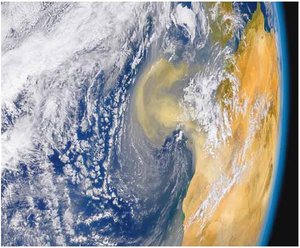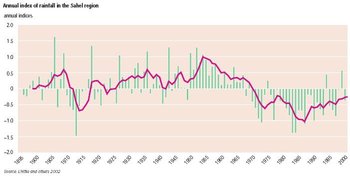Western Africa and the atmosphere
There are four climatic zones in Western Africa: Sahelian (rainy season does not exceed three months; irregular rainfall not exceeding 500 mm); Sudanian (precipitations between less than 88 mm in the north of Nigeria and 1,000 mm in the north of Mali); tropical humid (annual mean rainfall approximately 1,500 mm); and equatorial (essentially localized along the Gulf of Guinea, with annual rainfall above 2,000 mm).

A massive sandstorm blowing off the northwest African coast, blanketing hundreds of thousands of square kilometers of the eastern Atlantic Ocean with a dense cloud of Sahara Sand.
(Source: SeaWiFS Project, NASA/GSFC and ORBIMAGE)
The temperature in Western Africa is influenced by two air masses: the Harmattan, a dry and hot northeast wind blowing through the Sahara, and the monsoon, a humid southwest wind blowing through the Atlantic Ocean. These two air masses are controlled by the seasonal movement of the inter-tropical convergence zone and move from the north to the south. Rainfall patterns are unequally distributed through the subregion and influenced by this airflow. Greenhouse gas (GHG) emissions affect climate variability by generating, for example, a deficit in rainfall.
Greenhouse gas emissions in the region are low. However climate patterns are affected by global emissions, these variations have an effect on ecosystems and the economy (Market impacts of climate change). The immediate effect of climate variability is food insecurity: for example, groundnut production has virtually disappeared in Niger and a similar trend is evident in Senegal. The Sahel region – including Senegal, Mauritania, Mali, Burkina Faso, Niger, Nigeria and Chad – has experienced three decades of drought and patchy rain. The quality of rain is as important as the amount of rain, with heavy downpours and wind causing flooding, erosion and deterioration of the soil.
In addition to food insecurity, there is deterioration in air quality, especially in urban areas. The resulting pollution affects the quality of life of people in these areas. It also generates environmental costs and impacts on public health. Drought has resulted in increased dust generation in Western Africa and this affects not only the countries of the region but is believed to impact on climatic systems in the Caribbean and may affect coral reef health.
These challenges compel the sub-region to implement strategies to reduce the risks and place value on the available potentialities.
The utilization of renewable energy is still weak, but with effective policy interventions can increase in the short term. Wind (Wind farm) and solar energy is still underexploited.
Greenhouse gas (GHG) emissions affect climate variability and contribute to climate change (Causes of climate change) in the long term. Climate variability is a major threat to the utilization of biomass energy. Climate is an important element of the capacity of land to produce in quantity and quality, and extreme climatic events (drought, floods, sand wind, etc.) have important environmental and socioeconomic costs. Furthermore, global warming associated with GHG emissions has adverse effects on the climate. This can result in, for example, a reduction in the duration of the [[rain]fall] season.
Some adaptive measures to mitigate vulnerability to climate variability have been developed and are being implemented. These include measures to improve agricultural productivity through, for example, the setting up of integrated water resources management programs and the selection of species that are not prone to drought.
Facing climate modification requires the strengthening of climatic forecast and early warning systems, especially given the probability of further deterioration of rainfall patterns. To avoid water unavailability that may result from this, water collection and management systems are set up for irrigation and for domestic use.
Addressing the challenges of climate change (Causes of climate change) requires better implementation of the New Partnership for Africa's Development (NEPAD) climate change strategy, and specifically of projects dealing with:
- The elaboration of decision-making tools for assessing the vulnerability to climate;
- The promotion of initiatives and strategies to capitalize renewable energies; and
- The assessment of the synergetic effects of adaptation and mitigation activities through agroforestry pilot projects.
Further Reading
- IRIN, 2005. Senegal: Climate change impacting hard on semi-arid Sahel nations. Integrated Regional Information Networks.
- L’Hôte, Y., Mahé, G., Somé, B. and Triboulet, J., 2002. Analysis of a Sahelian annual rainfall index from 1896 to 2000; the drought continues. Hydrological Sciences, 47(4):563-72.
- UNEP, 2006. Africa Environment Outlook 2
|
|
| Disclaimer: This article is taken wholly from, or contains information that was originally published by, the United Nations Environment Programme. Topic editors and authors for the Encyclopedia of Earth may have edited its content or added new information. The use of information from the United Nations Environment Programme should not be construed as support for or endorsement by that organization for any new information added by EoE personnel, or for any editing of the original content. |
